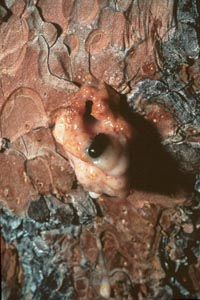Fort Collins Field Office – Insects & Diseases
Insects and diseases are a natural part of our native and urban forests. Eradicating insects and disease labeled as “pests” is not always feasible nor necessary. It is more beneficial to reduce the presence of pests to a level more in balance with the tree or forest.

In the Fort Collins area, the most common insects that we encounter as problems are various bark beetles, scale insects, spider mites and aphids. The most common disease is dwarf mistletoe.
Every conifer species in our forests has at least one associated bark-beetle with the potential to kill the tree. The most familiar ones in our area are mountain pine beetle in lodgepole pine and ponderosa pine; and Douglas-fir beetle in Douglas-fir.
For more information about mountain pine beetle, please click here.
Dwarf mistletoe is a parasitic plant that slowly kills a tree. A heavily infected tree has deformed branches, grows slowly, and produces few viable tree seeds.
In a municipal setting, scale and wood borers are typical insects. Fire blight and wetwood are common diseases.
Other tree issues we see include decline and death of low elevation aspen; stress and damage to trees near roads that receive magnesium chloride applications as a means of dust suppression, road stabilization or de-icing; and improper tree selection and planting.
Our foresters may be able to trouble-shoot problems from the office; otherwise they are available, by appointment, to assess an insect or disease problem on your favorite tree, on your property or within your subdivision.
Pamphlets addressing specific insects and disease are available in our office and at Colorado State University Extension.

